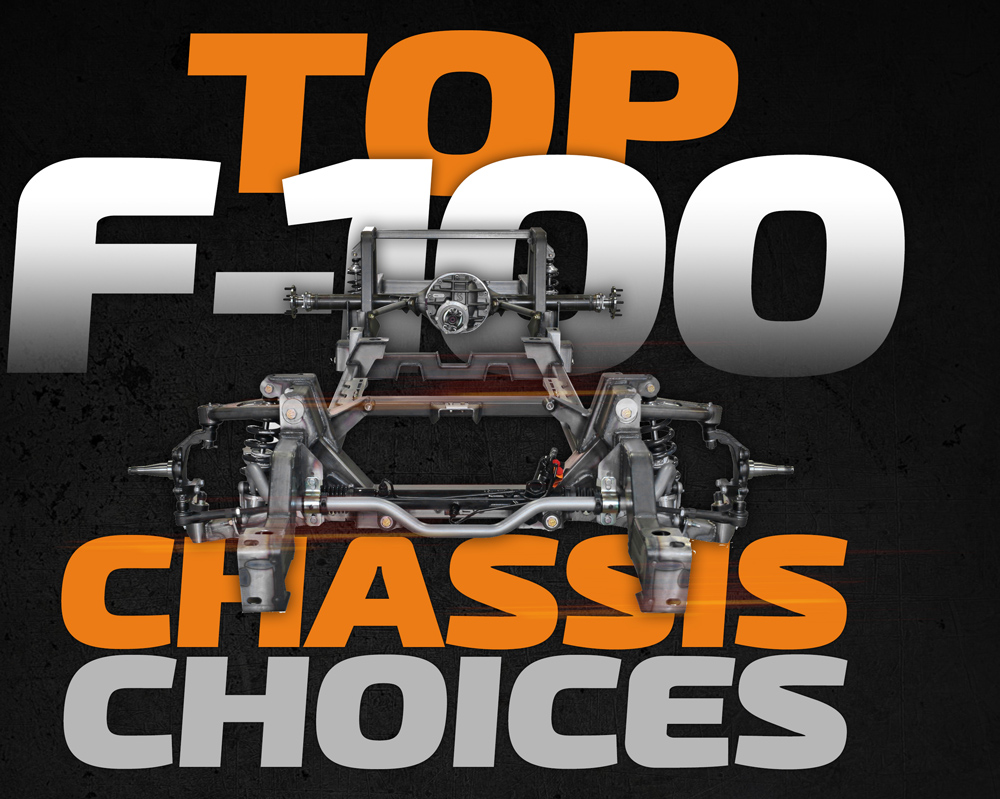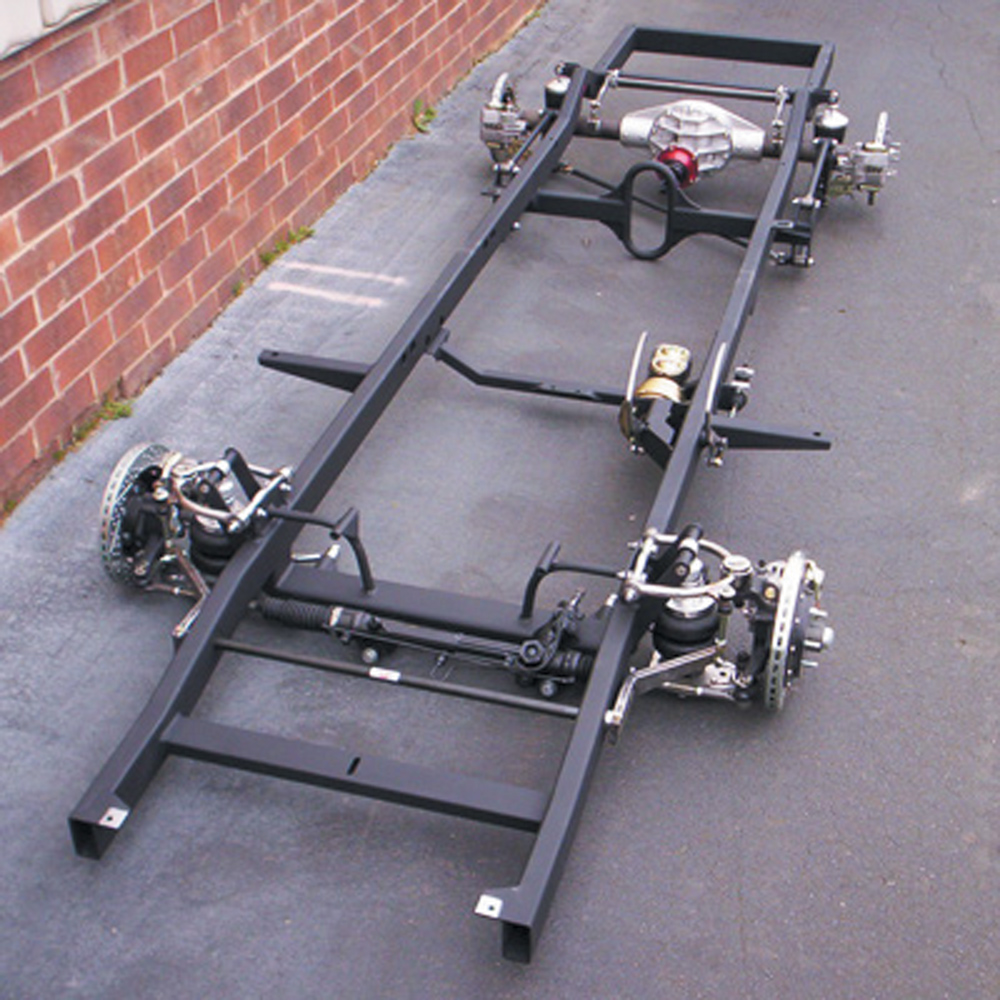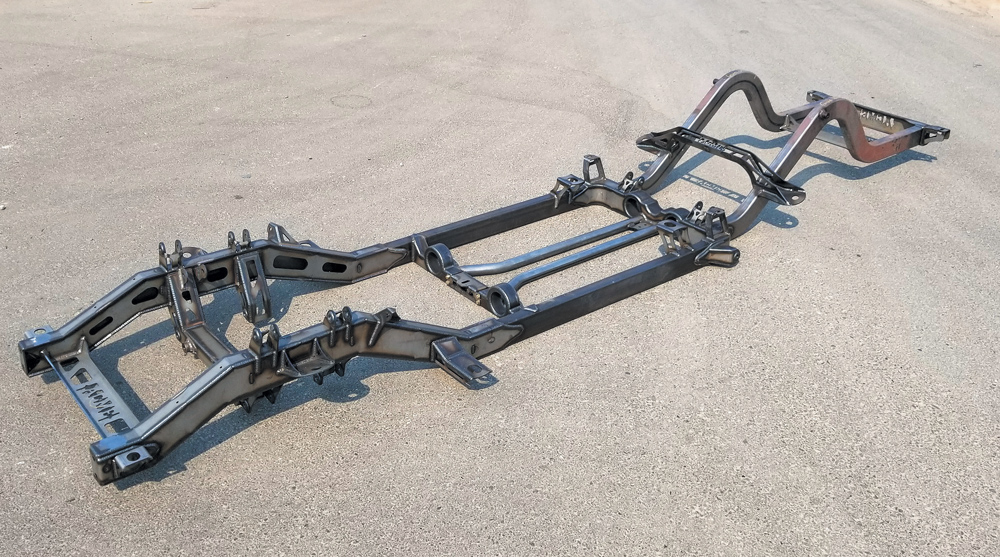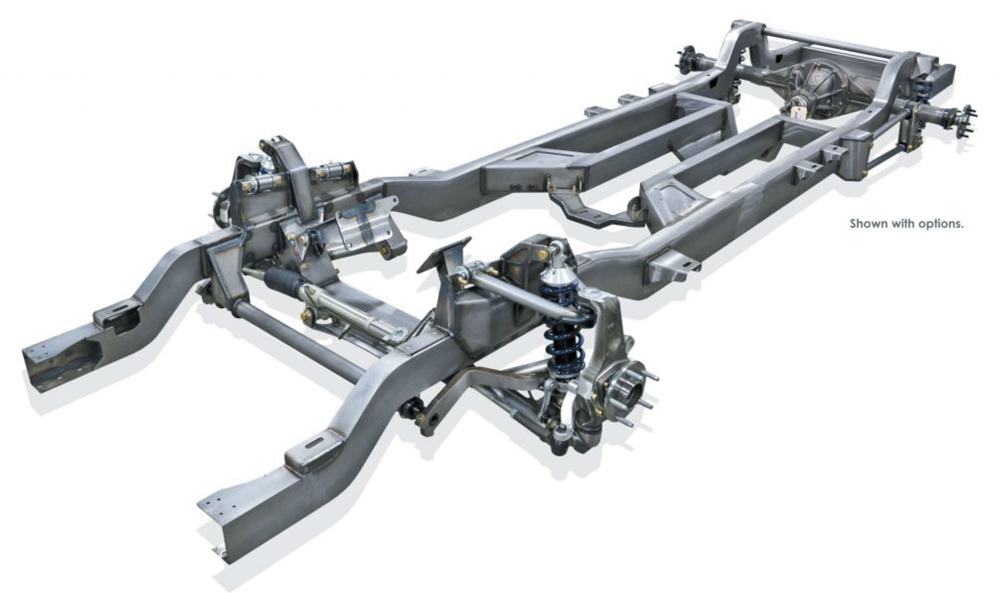 Ashok Kumar
.
April 01, 2020
.
F100 Builders
Ashok Kumar
.
April 01, 2020
.
F100 Builders

WE SCOURED THE GLOBE FOR THE BADDEST PRODUCTION F-100 CHASSIS OUT there to bring them all together in one place. There are a ton of advantages to purchasing a rolling chassis for your classic truck build, starting with the fact that these top companies put a lot of time (and moola) into engineering a well-thought-out solution from start to finish. Performance, handling, comfort, design, options and personal preference are features to consider when picking out the perfect foundation for your build. Here’s a look at the finest rollers we could find:

Art Morrison Enterprises
800-929-7188
www.artmorrision.com
Art Morrison has been a leading chassis builder for decades. Mandrel bent rail services, custom made-to-order rolling chassis, the works. It’s no surprise the company’s GT Sport Chassis line leads the way for muscle truck and classic truck enthusiasts alike. Up front you’ll find AME’s “Sport” independent front suspension with beefy 1 5/16-inch diameter upper control arms, upsized poly-bushed rod ends that work in concert with the premium coilover shocks and anti-sway bar, both of which are adjustable. A four-bar rear suspension with “Johnny-Joint” rod ends and a panhard bar keeps the reinforced Ford 9-inch rear end solidly planted for optimum acceleration and cornering. Adjustable coilover shocks tailor the handling and ride to your requirements.

Art Morrison Enterprises
800-929-7188
www.artmorrision.com
AME also offers “engineered to fit” exact year, make and model truck chassis custom rollers. No compromises here! Your choice of ride height and stance, superbly engineered suspension package provides vastly improved performance and handling, beefy 2×6-inch main rails with precision mandrelformed 2×4-inch 180-wall subframes. Frame is fixture-welded to assure proper alignment of all suspension components with choice of AME’s own IFS, Sport IFS or Air Spring-Plus front suspension. Triangulated four-bar, fourbar or Air Spring-Plus rear suspension options, and through-frame passages for 2.5-inch or 3-inch exhaust provide lower center of gravity and ample ground clearance.

GSI Machine & Fabrication
480-940-1806
www.gsimfab.com
GSI’s 1961-’64 F-100 air ride or coilover chassis is engineered with optimized suspension geometry to minimize camber movement throughout the suspension travel and help to eliminate bump steer. GSI’s lower control arm alignment cams allow for quick and easy suspension alignment. GSI’s tie rod adapter kit works with the suspension to eliminate bump steer and make alignment easy, and the rear is designed to accommodate a wide wheel setup (24×15-inch wheels). The GSI air ride or coilover chassis has been designed and developed using the latest technology available in manufacturing. Laser scanning a chassis is the best way to achieve proper fitment of all chassis components. High quality CNC laser, CNC water jet and CNC press brake machines ensure all parts will fit together at the welding bench and during installation. They also combine a full CNC machine shop in house to manufacture every piece to strict quality standards.


Bodie Stroud Industries (BSI Performance)
818-768-7600
bsiperformance.net
BSI Performance offers a ’53-’56 (other years available for custom order) fat fender chassis that delivers performance, handling, weight reduction, simple and super clean welds/fabrication with zero grinding. Designed and styled to be unique and clean, upgrades consist of Brembo/Wilwood brakes, complete Coyote or LS packages, engine/trans mounts of your choice, Magnaflow exhaust systems, fuel systems, rear end and radiator upgrades, and more. BSI chassis comes complete with BSI upper and lower control arms and four-link bars with patented EZ-Aline camber/caster adjusters integrated for quick and easy adjustments on the fly. Offering everything from rails to complete rollers, BSI has decades of build experience to deliver!

Scott’s Hot Rods
800-273-5195
www.scottshotrods.com
Each and every Scott’s chassis is built to order per the vehicle and customer specs. Coilovers (casual cruiser to Pro Touring) or airbags (lay frame/rocker, adjustable on-the-fly ride height), and you definitely won’t find any leaves or drum brakes here! Scott’s chassis are 100% TIG Welded 2x4x.120 wall tube frame rails with one-piece 2x4x3/16-wall tube IFS crossmember and an eight-point 1 1/2-inch DOM tubular chassis crossmember. Includes tubular upper and lower A-arms, 1 1/8×1/four-wall DOM with stainless steel CNC machined fully adjustable rod ends and oversized serviceable press-in ball joints. Also includes Aldan American single-adjustable coilovers or airbags and shocks and manual rack-and-pinion, as well as Moser Ford 9-inch housing and 31-spline axles, 1 1/8×1/four-wall DOM tubing link bars (adjustable RH- & LH-thread) with four-bar rear end housing brackets, all Grade-8 hardware and a lifetime guarantee.

No Limit Engineering
865-940-1503
www.nolimit.net
No Limit Pro-Tech Chassis for 1961-1979 F-100s will deliver improved handling, ride quality and performance for your classic hauler. Each chassis is custom built to your specifications. These chassis include the famous No Limit Wide Ride IFS with a 61.5-inch track width and proven No Limit Fat Bar Four-Link for the rear. The main chassis platform is 2x6x.120 wall rails, with a stout 2x6x.188 wall X-member. Exhaust porting and a drive shaft loop is standard. The formed front and rear rail sections are 2×6-inch blended down to 2x4x.188 wall. Base chassis includes the frame, cab, bed and bumper mounts, complete fat bar rear suspension with single adjustable coilovers, Mosier H.D. housing and axles, and brake line plumbing (High Nickel Steel). Will fit up to 11-inch wide front wheel with a 315 tire and 12-inch wide rear wheel with a 345 tire; wider wheel tubs required.

No Limit Engineering
865-940-1503
www.nolimit.net
NO Limit’s Big 10 Chassis for 1948-1960 F-100s is sold as a complete roller. This includes: complete front suspension, including power rack-and-pinion, front sway bar and disc brakes; Ride Tech billet coilover shocks standard front and rear; complete trailing arm rear suspension with rocker arms and links standard; Mosier-Ford 9-inch rear end with 31 spline axles, 60-inch overall width with all brackets welded in place; brake pedal, booster and master cylinder, valving and all brake line plumbing included; motor and transmission mounts; motor adapter plates, motor poly mounts, trans poly mount and rack-and-pinion fittings. No Limit Big 10 chassis is one of the most complete chassis packages on the market and can include custom running board mounts as needed.

Fatman Fabrication
704-545-0369
www.fatmanfab.com
Get the improvement you crave with the precision and proven geometry in the Fatman Ford truck chassis. Fatman Fab manufacturers a complete 1948–1979 Ford truck chassis with multiple options to make your classic perform exactly as you want it to! As an accredited manufacturer, Fatman can supply this chassis with a legal VIN number and a Statement of Origin to help you title a complete reproduction build or restoration. Fatman’s frames are built using heavy 0.188-inch wall rectangular tubing for more strength and engineered from front to back.

Roadster Shop
847-949-7637
www.roadstershop.com
RS SPEC is an engineering-focused approach using the latest in manufacturing technology to build the lightest, strongest and easiest-to-install complete chassis system. These technologies have been used to streamline procedures resulting in lower cost and shorter lead times. The SPEC IFS is engineered to deliver outstanding performance wrapped in a user-friendly package. A completely new proprietary suspension geometry has been designed to provide the best balance of ride quality and performance. The engineered solution is designed with aggressive 4-inch ride height that will lay rockers on the ground with air bag suspension. Frame rail designs to accommodate mini-tubs and up to 12-inch-wide wheels and rear frame kick up are engineered for minimal bed modification while allowing the truck to lay rockers on the ground for the ultimate in lows.

Acme Chassis Factory
559-281-2919
acmechassisfactory.com
ACME Chassis Factory line of Ford truck chassis are currently available for all Ford trucks and SUVs from 1947-1997. Acme frames come set up for airbags or coilovers and have a ton of options for suspension choices/ configurations. All chassis are built using the latest high-end technology and are completely 3-D modeled. From there, the front rails are constructed from laser cut and CNC formed 3/16-inch cold rolled steel. The rear rails are precision built to tight tolerances. The lower control arms are designed and built with laser cut plates with internal gussets, much like a trophy truck. The upper arms are fully adjustable for camber and caster alignment. The rear suspension features a triangulated three-link with fully boxed lower links and a tubular upper link or a parallel four-link with a watt’s link. All machined parts are produced with CNC machines to exacting standards and tolerances. The chassis and components are all assembled and fully welded in precision jigs and fixtures to ensure a perfect fit, every time, with ‘bag on bar style rear suspension, ride-quality and performance and engineered into every single build. Give them a call today to customize your next project roller!

Roadster Shop
847-949-7637
www.roadstershop.com
The Roadster Shop 1948-1956 REVO IFS Chassis has been created from the ground up, leaving behind the antiquated Mustang II geometry and ride quality where it firmly belongs: in the past. Controlled roll centers, eliminated bump steer, and CAD optimized camber and caster curves provide a suspension that offers the absolute best combination of ride quality and street performance. With 5.5 inches of wheel travel and positive and negative bump stops, the REVO front end allows smooth articulation through the full range of motion, creating the most comfortable, balanced and street friendly dynamics possible.
A new and innovative integrated sway bar design allows the use of a 1-inch OD splined sway bar tube, with no external mounting necessary. The carefully designed packaging leaves one of the smallest crossmember footprints available today, leaving you with more room and clearance to position your drivetrain where you want it without compromise.
The REVO front end has been designed from scratch using the latest CAD development software and design processes. Roadster Shop designed and manufactured 115 unique components for this suspension, allowing a fresh design template to build the ultimate IFS without compromise.

Schwartz Performance
815-206-2230
schwartzperformance.com
The Schwartz Performance 1948- 1952 G-Machine Chassis replaces the old, weak frame that your cab/bed, suspension components and engine are currently mounted to. With the G-Machine Chassis, your Ford F1’s body will encounter much less flex and better ride quality, resulting in an all-around better performing vehicle. A bolt-in design integrates all of the original core support, cab and bed mounting points, and the floorplan does not need to be cut out, although some transmissions will require tunnel modifications. It’s designed to accept big block and small block Ford engines, as well as DOHC mod motors like the 4.6L and 5.0L Coyote (rear sump oil pan required on all engines) and can cater to virtually any engine/trans combos out there. All G-Machine Chassis allow for up to 345 mm-wide rear tires if you mini-tub the bed sides. Moser full-floating 9-inch rear is narrowed to 60 inches to allow fitment for deeper dish wheels. Different rear end widths available as well. Schwartz Performance can also make any post-1952 Ford truck chassis as well.

Speedtech Performance USA
435-628-4300
speedtechperformance.com
The Speedtech ExtReme chassis provides you with an easy-to-install, high-quality, USAmade F-100 chassis system that’s customized just for you. It can include heavy duty tube rails with fully welded and internally gusseted box style front and rear chassis clips, high clearance upper and lower front control arms assembled with greaseable Delrin bushings and heavy-duty ball joints that allow up to 315 mm tires up front. Your package can include new ExtReme aircraft spec 7075 T73 Forged aluminum spindles with heavy duty C7 Corvette hubs and tuned, adjustable, splined sway bar with street, autocross and ExtReme race options. A Sweet Mfg. race bred performance power rack-and-pinion steering paired with JRI single adjustable shocks with Speedtech valving and Draco springs in your choice of spring rate create the ultimate in performance handling! Includes Torque Arm rear suspension system including Articulink lower trailing arms and heavy-duty Dutchman 9-inch Ford housing with prewelded brackets and 31 Spline Pro Street axles.
What engine and transmission were used in the modified 1955 Ford F100?
The modified 1955 Ford F100 boasts a robust powertrain under the hood. It features a high-performance engine coupled with a reliable automatic transmission. Specifically, this classic truck is equipped with a potent engine that delivers impressive power and efficiency. Complementing this engine is the smooth-shifting 6R80 automatic transmission, known for its durability and performance.
This combination ensures the modified Ford F100 not only runs smoothly but also delivers an exhilarating driving experience.
What specific tires and wheels were used in the front and rear of the modified 1955 Ford F100?
Tire and Wheel Specifications for the Modified 1955 Ford F100
What are some of the modifications made to the front wheels and fender openings of the 1955 Ford F100?
To enhance the wheelbase and properly position the front wheels within the fenders of the 1955 Ford F100, several modifications were executed. First, the wheel arches were carefully detached and repositioned forward to center the front wheels. The existing edges around the wheel openings were preserved to maintain the truck’s classic look. Additionally, the sections behind the wheel wells were filled in using 16-gauge sheet metal. These precise adjustments contributed to a more aesthetically pleasing and balanced profile for the vehicle.
What are some unique features of the custom fuel tank in the 1955 Ford F100?
The 1955 Ford F100 boasts a custom fuel tank that showcases several unique and innovative features:
In summary, the custom fuel tank in the 1955 Ford F100 is designed with meticulous attention to detail, enhancing both functionality and aesthetic appeal.
What changes were made to the firewall of the 1955 Ford F100?
The 1955 Ford F100 saw a notable modification to its firewall. Unlike the common practice of moving the firewall backward, engineers made a unique decision to shift it forward. This adjustment served two primary purposes:
To make these changes feasible, the engine and transmission were moved forward to the maximum extent practical. This strategic repositioning achieved the dual goals of increased cabin space and more efficient use of the vehicle’s internal components.
How was passenger legroom increased in the 1955 Ford F100?
The 1955 Ford F100 saw notable enhancements in passenger comfort, particularly in the area of legroom. The design improvements were strategically implemented to ensure spaciousness and driver ease.
To create more legroom for passengers, designers made a significant adjustment to the firewall. Instead of the conventional approach of moving the firewall backward, it was actually moved forward by 4 inches. This forward shift opened up additional space within the passenger compartment.
In conjunction with the firewall adjustment, the engine and transmission were repositioned. These components were moved forward as far as practically possible. This relocation helped to make room for under-dash pedal assemblies, further contributing to the enhanced legroom for passengers.
These modifications provided more room for occupants, offering a more comfortable driving experience without compromising the overall functionality of the vehicle.
How did Roadster Shop improve the chassis of the 1953-1955 Ford F100?
Roadster Shop’s work on the 1953-1955 Ford F100 chassis brought a series of thoughtful improvements that transformed the vehicle into a modern masterpiece while preserving its classic appeal.
One of the most significant upgrades includes the installation of independent front and rear suspension systems. This change dramatically enhances the truck’s handling and ride comfort, giving it a more contemporary driving experience.
The vehicle’s wheelbase was extended by 6 inches, from the stock 110 inches to 116.75 inches. This modification offers improved stability and a more balanced look overall. Specifically, the front tires were upgraded to 245/50R18 on 18×7.5 wheels with 5-inch backspacing, while the rear tires are now 255/55R18 on 18×8 wheels, also with 5-inch backspacing.
To align with the extended wheelbase and ensure the front wheels were centered in the fenders, the wheel arches were repositioned. The team retained the stock lips around these openings and filled in the area behind the wheels with 16-gauge sheet metal. This meticulous adjustment contributes to a more balanced and aesthetically pleasing profile.
A significant focus was placed on improving passenger comfort. To provide additional legroom, the firewall was moved forward by 4 inches. This repositioning allows for more space within the cab and also accommodates under-dash pedal assemblies, enhancing overall ergonomics.
Innovative storage compartments were added beneath the bed floor of the truck. These hinged sections offer easy access to storage spaces and a spare tire, making use of often-unused space and adding practical functionality.
To optimize space and performance, the engine and transmission were moved forward as far as was practical. This repositioning facilitates better weight distribution and aligns with the newly extended wheelbase and repositioned firewall.
By focusing on these strategic modifications, Roadster Shop has crafted a vehicle that seamlessly blends classic styling with modern performance and comfort. Each change, while subtle, contributes to a cohesive and improved driving experience.
What custom components does Roadster Shop produce for their vehicles?
<Roadster Shop>Roadster Shop offers an extensive range of custom components designed to elevate any vehicle project. In their 30,000-square-foot facility, they craft bespoke chassis and suspension systems tailored to specific build requirements.
Their expert team also handles metal fabrication, vehicle construction, and paint and body work. For those seeking comprehensive modifications, the shop’s mechanical department assembles turnkey vehicles and performs customer vehicle servicing and component installation.
Furthermore, <Roadster Shop>Roadster Shop leverages 3D printing technology to produce unique, one-of-a-kind parts that meet exact specifications. This ensures each project receives fully customized components, enhancing both performance and aesthetics.
What changes were made to the wheelbase of the 1955 Ford F100 by Roadster Shop?
To modify the wheelbase of the 1955 Ford F100, the team at Roadster Shop stretched it from the original 110 inches to 116.75 inches. This extension involved more than just lengthening the frame. To ensure the front wheels were appropriately centered within the fenders, the wheel arches were carefully cut and repositioned forward. These intricate adjustments provide the vehicle with a balanced and enhanced appearance, all while maintaining the seamless integration Roadster Shop is renowned for.
How does Roadster Shop handle the assembly of turnkey vehicles and customer servicing?
How Roadster Shop Handles Turnkey Vehicle Assembly and Customer Servicing
Roadster Shop specializes in managing every aspect of vehicle projects, from initial design to final delivery. Their extensive 30,000-square-foot facility houses everything needed to execute projects efficiently and impeccably.
Not just limited to building new vehicles, the facility also excels in servicing and upgrading existing customer vehicles. This includes:
By centralizing these capabilities, Roadster Shop ensures seamless integration between each phase of the vehicle build and servicing process, guaranteeing a high level of craftsmanship and customer satisfaction.
What role does metalwork play in Roadster Shop’s modifications?
Metalwork is fundamental to the Roadster Shop’s vehicle modifications, ensuring that every upgrade seamlessly integrates with the original design. Precision metalwork allows for enhancements, such as fender adjustments, to be completely undetectable, maintaining the vehicle’s authentic look. This high level of craftsmanship ensures the modifications not only perform well but also preserve the car’s aesthetic integrity.
With skilled metal artisans working meticulously on each modification, Roadster Shop ensures an impeccable finish that both performs and looks impeccable.
How does Roadster Shop integrate design features into their modifications?
Roadster Shop excels in seamlessly incorporating innovative design features into their vehicle modifications, often in ways that require a discerning eye to fully appreciate. Their approach to a 1955 Ford F100 offers an illustrative example of their expertise.
A primary technique involves modifying the chassis to achieve the desired vehicle profile. For the Ford F100, they based the modifications on a custom chassis with independent front and rear suspension. They extended the wheelbase from the standard 110 inches to 116.75 inches. This meticulous adjustment required precise alterations to the vehicle’s framework.
A key visual modification is relocating the wheel arches to better center the front wheels within the fenders. They achieved this by cutting loose the wheel arches and moving them forward, while maintaining the stock lips around the openings. The gap created behind the wheel wells was filled with 16-gauge sheet metal, ensuring the alteration looks like it belongs. This subtle yet impactful change enhances the truck’s overall balance and profile.
Interior space and ergonomics are another major focus. For the Ford F100, they advanced the firewall by 4 inches to create more legroom for passengers. This move also involved relocating the engine and transmission forward as far as feasible, which allowed for under-dash pedal assemblies without compromising cabin space.
Through careful planning and precise execution, Roadster Shop integrates numerous design enhancements into their modifications. Every alteration, from the chassis and wheelbase adjustments to the firewall repositioning, is meticulously carried out to achieve a harmonious blend of form and function. This approach ensures that their custom vehicles not only perform exceptionally but also exhibit a refined and balanced appearance.
How does Roadster Shop ensure the structural integrity of their fender modifications?
<Roadster Shop>Roadster Shop ensures the structural integrity of their fender modifications through meticulous attention to detail and expert craftsmanship. Here’s how they achieve this:
This comprehensive approach guarantees that the modified fenders not only look flawless but also uphold the structural standards necessary for high-performance vehicles. Every step, from cutting to finishing, is executed with precision and expertise, ensuring durability and integrity.
How did Roadster Shop modify the fenders to accommodate the lengthened wheelbase?
To accommodate the lengthened wheelbase, the Roadster Shop implemented a series of meticulous modifications to the fenders. Initially, they cut away the factory wheel openings on the front fenders to allow for the necessary adjustments. Temporary supports were tack-welded into place to retain the proper shape of the fenders during this process.
Next, these wheel openings were carefully trimmed and repositioned forward on the fender, then securely clamped into their new position. To address the gaps left at the rear of the fender openings, they fabricated filler panels from 16-gauge steel and welded these pieces in, ensuring a seamless and solid finish.
The precision metalwork employed in these modifications renders them virtually undetectable to the naked eye, demonstrating the high level of craftsmanship involved.
How does Roadster Shop’s use of 3D printing contribute to their vehicle modifications?
Roadster Shop enhances their vehicle modifications through the innovative use of 3D printing technology. This advanced method allows them to create highly customized, one-of-a-kind components tailored specifically for each project.
In summary, 3D printing empowers Roadster Shop to deliver unparalleled personalization and quality in their vehicle modifications, setting a new standard in the industry.
How did Roadster Shop utilize the space below the bed floor of the 1955 Ford F100?
Roadster Shop showcased remarkable ingenuity by transforming the underutilized space below the bed floor of the 1955 Ford F100 into practical storage solutions.
They integrated compartments beneath the bed floor, accessible via hinged sections. These compartments make use of typically wasted space, effectively creating hidden storage areas. A spare tire is also conveniently stowed here, maximizing utility without sacrificing aesthetics.
The bed floor itself is partitioned into two hinged sections. The forward section, equipped with crossmembers for added strength, conceals two storage compartments. Gas struts assist in lifting these sections, ensuring easy access.
Further enhancing storage capacity, a custom tray has been installed above the fuel tank. This tray not only provides additional storage but also houses a spare tire. The design ensures that it fits snugly between the rear frame rails, utilizing every inch of available space.
When closed, these lids feature stainless steel rub strips that overlap the wood planks, seamlessly hiding the storage compartments. Recessed cargo tie-downs in the bed’s corners, with removable rings in machined aluminum receptacles, add to the practicality without disrupting the clean look.
By reimagining these typically unused spaces, Roadster Shop has significantly increased the functionality of the 1955 Ford F100, blending clever design with practical solutions.
Share Link